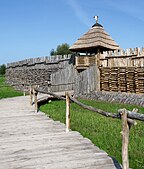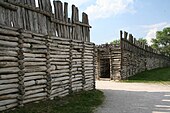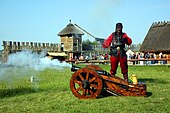Biskupin
 Reconstructed gateway at Biskupin | |
| Location | Biskupin, Kuyavian-Pomeranian Voivodeship, Poland |
|---|---|
| Coordinates | 52°47′18″N 17°44′40″E / 52.78833°N 17.74444°E |
| Type | Settlement |
| History | |
| Material | Wood |
| Founded | c.747–748 BC[1] |
| Site notes | |
| Condition | In ruins, partially reconstructed |
| Designated | 1994-09-08 |
| Reference no. | M.P. z 1994 r. Nr 50, poz. 412[2] |
Biskupin (Polish: [bisˈkupin]) is an archaeological site and a life-size model of a late Bronze Age fortified settlement in north-central Poland that also serves as an archaeological open-air museum. When first discovered it was thought to be early evidence of a West Slavic settlement, but archaeologists later confirmed it belonged to the Biskupin group of the Lusatian culture from the 8th century BC. The excavation and the reconstruction of the prehistoric settlement has played an instrumental part in Polish historical consciousness.
The Museum is situated on a marshy peninsula in Lake Biskupin, ca. 90 kilometres (56 miles) northeast of Poznań and 8 km (5 mi) south of the small town of Żnin. In the years 1956–2000, it was a division of the National Museum of Archaeology in Warsaw. After the Polish local government reforms of 1998, Biskupin was granted the status of an independent institution known as the Archeological Museum in Biskupin.[3]
The site is one of Poland's official national Historic Monuments (Pomnik historii), as designated September 16, 1994, and tracked by the National Heritage Board of Poland.[4][5]
History of the excavations
[edit]In 1933 Polish archaeologists discovered remains of a Bronze Age fort/settlement in Wielkopolska Region (Greater Poland) and the discovery became famous overnight. The site was excavated from 1934 onwards by the team from Poznań University, led by archaeologists Józef Kostrzewski (1885–1969) and Zdzisław Rajewski (1907–1974).[6] The first report was published in 1936. By the beginning of 1939, ca. 2,500 m2 (26,909.78 sq ft) had been excavated. Biskupin soon became famous, attracting numerous distinguished guests, including officials of the Marshal Piłsudski government, members of the military, and high churchmen such as the primate of Poland. The site soon became part of Polish national consciousness, the symbol of achievements of the Slavonic forebears in prehistoric times. It was called the "Polish Pompeii" or "Polish Herculaneum".[7] The existence of a prehistoric fortress, 70 km (43 mi) from the German border, was used to show that the prehistoric "Poles" had held their own against foreign invaders and plunderers as early as the late Bronze Age. Biskupin came to feature in paintings and popular novels.
When the Germans occupied Poland in the autumn of 1939, Biskupin was renamed "Urstädt".[8] In 1940, excavations were resumed by the SS-Ahnenerbe until 1942. When the Germans were forced to retreat they flooded the site hoping to destroy it, but—ironically—it led to very good preservation of the ancient timbers. Excavations were resumed by Polish archaeologists after the war and continued until 1974.[9]
The site
[edit]There are two settlement periods at Biskupin, which was located in the middle of a lake but is now situated on a peninsula, that follow each other without a break. Both settlements were laid out on a rectangular grid with eleven streets that are three metres (9.8 ft) wide. The older settlement from the late Bronze Age was established on a slightly wet island of over 2 hectares (4.9 acres)[10] and consisted of around 102-106 oak and pine log-houses[11] that were of similar layout, measuring ca. 8 by 10 metres (26 by 33 feet) each. They consisted of two chambers and an open entrance-area. These houses were designed to accommodate 10–12 persons. An open hearth was located in the centre of the biggest room. There are no larger houses that could indicate social stratification. Because of the damp, boggy ground the streets were covered with wooden planks.
The settlement was surrounded by a tall wooden wall, or palisade, set on a rampart made up of both wood and earth. The rampart was constructed of oak trunks that form boxes filled with earth. The rampart is more than 450 metres (1,480 feet) long and accompanied by a wooden breakwater in the lake. 6,000 to 8,000 cubic metres (210,000 to 280,000 cubic feet) of wood was used in the construction of the rampart.[12]
In popular culture
[edit]The Biskupin archeological site was featured on stamps issued by the Polish Post in 1966 and 1978.
The settlement served as a setting in a number of films including Jerzy Hoffman's 1998 historical drama With Fire and Sword[13] and 2003 historical film An Ancient Tale: When the Sun Was a God.[14]
In August 2018, the Biskupin settlement was celebrated with a Google doodle on the 85th anniversary of the discovery of the site.[15]
Dating
[edit]
The settlement at Biskupin belongs to the Hallstatt C and D periods (late Bronze Age/early Iron Age, 800–650 BC and 650–475 BC). There are four radiocarbon dates from Biskupin (all B.C.):
- First settlement: 720±150 (Gif 494)
- Later settlement: 560±150 (Gif 495)
- Rampart: 620±150 (Gif 492)
- A2 4C, VII: 620±150 (Gif 493)
However, dendrochronological analysis provided more accurate dating. It proved that oak wood used in the construction of the settlement was cut down between 747–722 B.C. Over half of the wood used was cut during the winter of 748/747 B.C.[16][17]
The model
[edit]In 1936 the first life-size model (open-air museum) was built on the peninsula, but it was intentionally destroyed by retreating Germans near the end of World War II. After the war it was rebuilt, and the ramparts and one full street with houses on both sides were also added.
In the 2000s, a film prop "medieval" timber castle was constructed on a part of the original site.
Gallery
[edit]-
Reconstruction of the settlement
-
Reconstructed entrance gate
-
Most recent gate and wall
-
The interior of a hut
-
Reconstructed walls
-
Model of the Bronze Age settlement
-
Reconstructed huts
-
Archeological Festival in 2009
Bibliography
[edit]- Danuta Piotrowska, Biskupin 1933–1996: archaeology, politics and nationalism. Archaeologia Polona 35–36, 1997/98, 255–285, ISSN 0066-5924
- Józef Kostrzewski "Osada bagienna w Biskupinie w pow. żnińskim", Poznań 1936
- "Gród prasłowiański w Biskupinie", Poznań 1938,
- Z. Rajewski "Biskupin – osiedle obronne sprzed 2500 lat", Arkady, Warszawa 1970,
- Z. Rajewski "Osadnictwo ludności z kulturą łużycką we wczesnym okresie epoki żelaznej w Biskupinie i okolicy" Archeologia Polski, t. II 1958,
- Z. Rajewski "10 000 lat Biskupina i jego okolic", Warszawa 1965,
See also
[edit]- Castles in Poland
- Archeology
- Bronze Age
- Kuyavian-Pomeranian Voivodship
- Lusatian culture
- Pałuki
- Wenecja
- Żnin
- Gąsawa
References
[edit]- ^ "Biskupin 'postarzał się' o 200 lat. 85. rocznica odkrycia osady i 25-lecie ustalenia daty jej założenia". poznan.wyborcza.pl.
- ^ Zarządzenie Prezydenta Rzeczypospolitej Polskiej z dnia 8 września 1994 r. w sprawie uznania za pomnik historii., M.P., 1994, vol. 50, No. 412
- ^ Judyta Ostapiak-Jagodzińska (8 December 2020). "Biskupin –ikona polskiej archeologii". histmag.org (in Polish). Retrieved 3 February 2024.
- ^ "Szlakiem miejsc niezwykłych - Pomniki Historii s.I - Biskupin". tvp.pl (in Polish). Retrieved 3 February 2024.
- ^ "100 POMNIKÓW HISTORII NA STULECIE ODZYSKANIA NIEPODLEGŁOŚCI". biskupin.pl (in Polish). Retrieved 3 February 2024.
- ^ Marek Kępa (7 July 2021). "Biskupin: The Polish Pompeii". culture.pl. Retrieved 3 February 2024.
- ^ Łukasz Starowieyski (31 August 2023). "Rówieśnik Rzymu, polskie Pompeje. 90 lat temu okryty został Biskupin". dzieje.pl (in Polish). Retrieved 3 February 2024.
- ^ "Biskupin – A Discovery That Shocked Archeology". polishhistory.pl. Retrieved 3 February 2024.
- ^ Rajewski, Zdzisław (1965). 10000 lat Biskupina i okolic [10000 years of Biskupin and surrounding areas] (in Polish). Warsaw: Państwowe Zakłady Wydawnictw Szkolnych. p. 5-6.
- ^ Z. Rajewski "Biskupin – osiedl obronne sprzed 2500 lat", Arkady, Warszawa 1970
- ^ "BISKUPIN – STRONGHOLD OF THE LUSATIAN CULTURE". medievalheritage.eu. Retrieved 3 February 2024.
- ^ Szymon Modzelewski (6 April 2021). "GRÓD W BISKUPINIE". opiekun.kalisz.pl (in Polish). Retrieved 3 February 2024.
- ^ "OGNIEM I MIECZEM". filmpolski.pl (in Polish). Retrieved 3 February 2024.
- ^ "Jerzy Hoffman zaprezentował "Starą baśń" w Bydgoszczy". wp.pl (in Polish). 16 September 2003. Retrieved 3 February 2024.
- ^ "85th Anniversary of the Biskupin Settlement Discovery". doodles.google. 31 August 2018. Retrieved 3 February 2024.
- ^ "- From the history of Biskupin research – Muzeum Archeologiczne w Biskupinie". biskupin.pl. Archived from the original on 2016-10-31.
- ^ "- Z dziejów badań Biskupina – Muzeum Archeologiczne w Biskupinie". biskupin.pl. Archived from the original on 2015-12-30.










